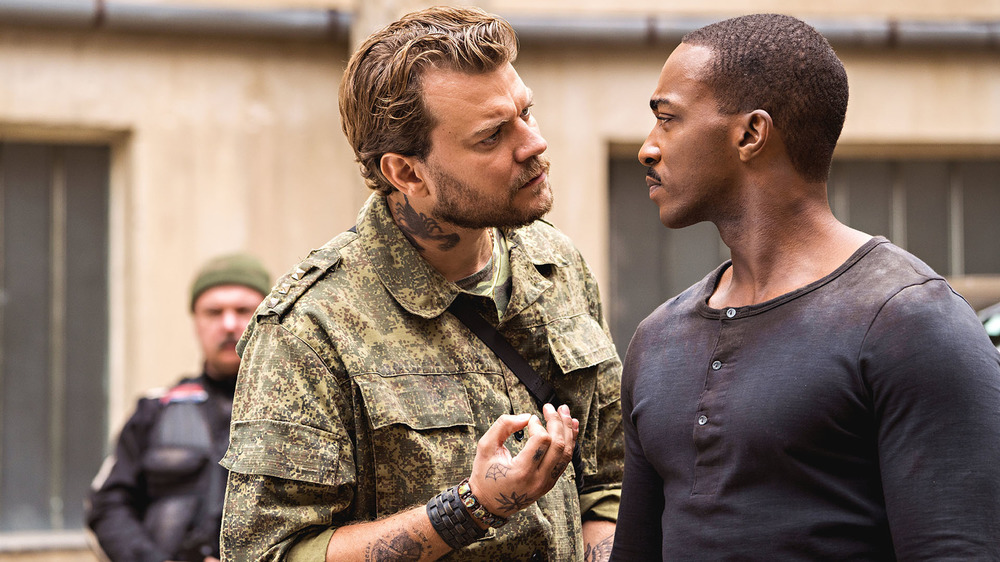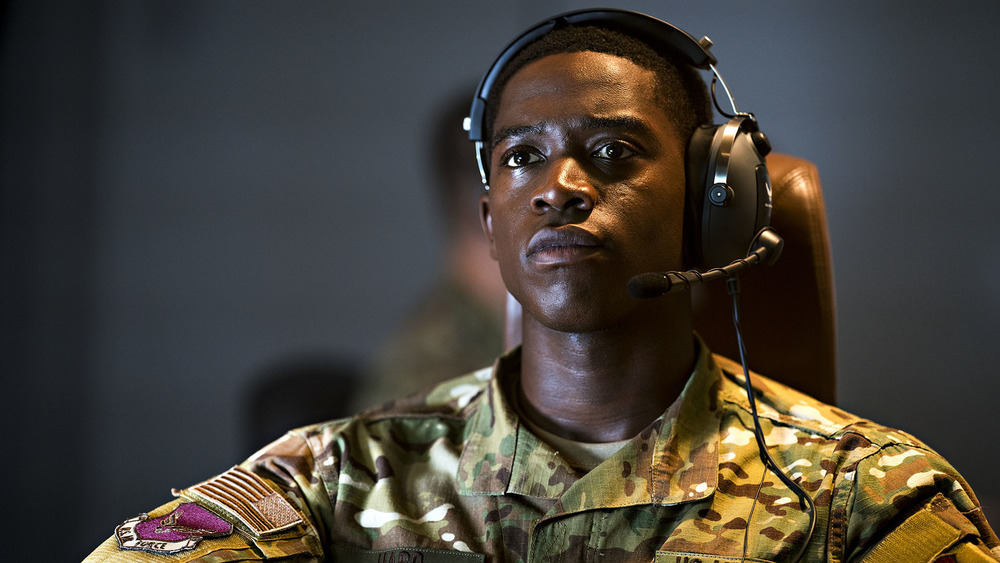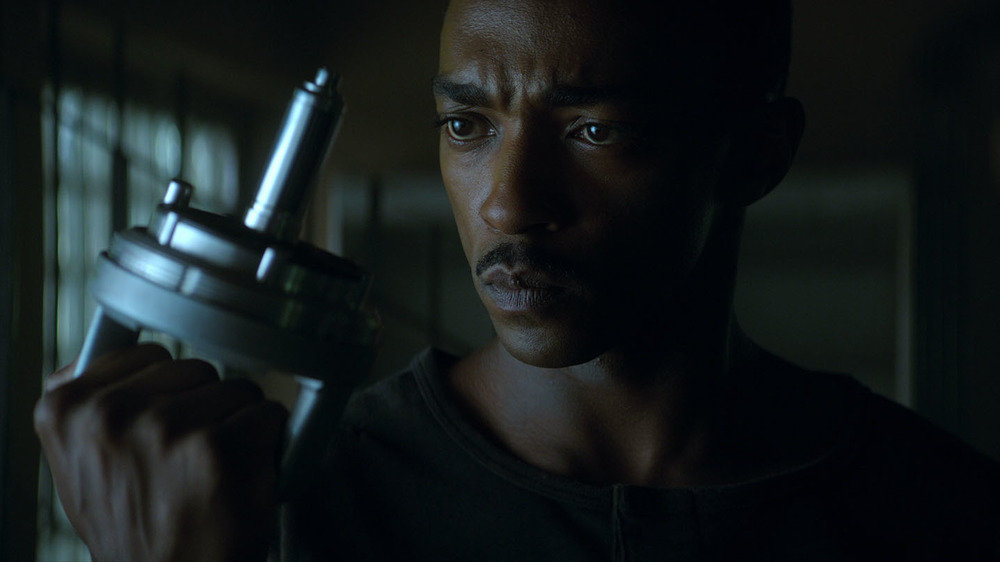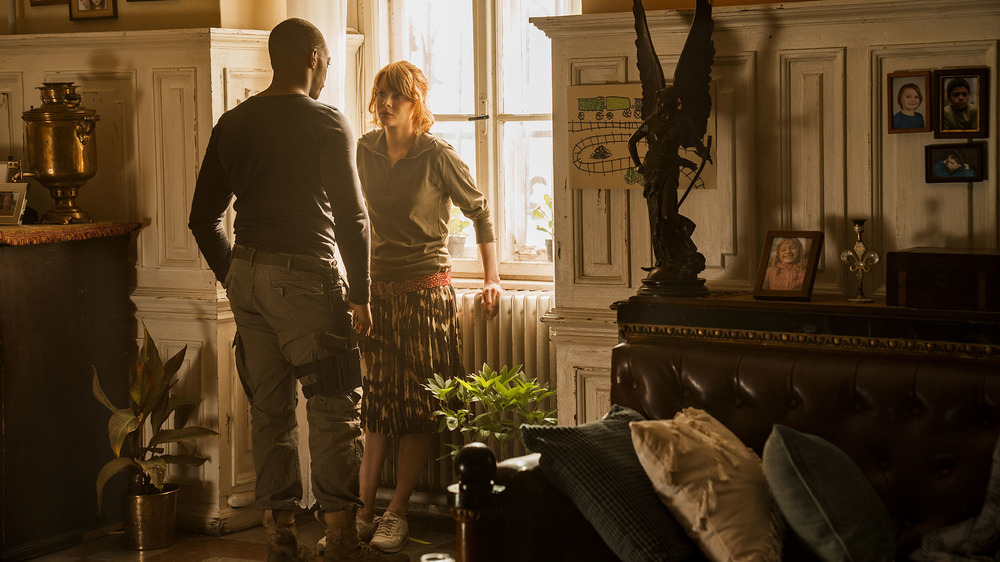Small Details You Missed In Outside The Wire
This content was paid for by Netflix and created by Looper.
Outside the Wire isn't your typical sci-fi action film. Sure, it features a number of breathtaking fight scenes. And yeah, you'll get to watch Anthony Mackie run around as a robot, kicking all sorts of butt. But Outside the Wire also has something to say about warfare, technology, and the intersection between the two, and it's made with an attention to detail that makes the film's stark and gritty near-future world feel all the more convincing.
In fact, for all of its bombast, much of Outside the Wire's best worldbuilding is subtle enough that you may not see it unless you're know where to look. And hey, who could blame you? Between the gumps, the nuclear bombs, the intense battle sequences, and the delightful chemistry between Lt. Thomas Harp and Captain Leo, we'd forgive you for being a little distracted. Here are the small details you might've missed in Outside the Wire.
Look for the signs
For most of Outside the Wire, Viktor Koval (played by Euron Greyjoy actor Pilou Asbæk) remains off screen, but his presence is everywhere. Not only does his plot to retrieve old Soviet nuclear codes drive all of the movie's action, but his forces pop up time after time to cause trouble for Harp, Leo, the gumps, and the rest of the American military.
However, while Harp and Leo often find themselves taken by surprise by Koval's attacks, viewers often get a little warning — if they're watching carefully, that is. In Outside the Wire, Koval's unique symbol, which looks a little bit like a "v" with a tick through it, is everywhere. It appears on a wall during the firefight that opens the film. It also appears numerous times in Leo's collection of photographs documenting Koval's activities.
Once Harp and Leo get out in the field, the symbol takes on a prophetic quality. One of the symbols is graffitied on the side of a building that Leo and Harp pass just before gunfire stops their motorcade and downs a group of scavengers. There's another scrawled on the wall inside the shelter they visit while dropping off the vaccine, foreshadowing the sniper attack inside. As the duo drive to the bank where the nuclear codes are held, they pass a barricade sporting the symbol, and naturally, it's all over the flags in Koval's compound. Basically, any time that an attack by Koval's forces is imminent, the symbol appears. For our heroes, it's never good news.
Bouncing here and there and everywhere!
Thomas Harp isn't just a soldier. Outside of the military, he has a full and complete life that includes an adoring fiancee and a wedding to plan. Thanks to his role as a drone pilot, he gets to see his fiancee, Olivia, fairly often, and, as he tells Leo, the relationship is good. Harp isn't just faithful to Olivia. He finds the idea that they'd be cheating on each other absurd. Heck, Olivia even has a cute pet name for Harp, which Leo finds absolutely delightful: "Gummy Bear."
Outside the Wire never explains where Harp got this name, but the opening sequence offers one big clue. When we first meet Harp, he's sitting at his control station, guiding a military drone over Krazny from thousands of miles away. There's a picture of Olivia taped to his screen, and he's casually snacking from a bag of — that's right – gummy bears.
Thematically, "Gummy Bear" isn't a bad label for Harp, either. Unlike Leo, whose body is cold, steely, and lifeless and whose morals are similarly fairly rigid, Harp is human. His body is "squishy," and his mind can change. Sure, "Gummy Bear" is a funny nickname, but it also sets Harp apart from Leo — something that becomes very important as Outside the Wire pushes towards its climax.
Judging him by his covers
Outside the Wire does an excellent job building up Captain Leo before we meet him, making his entrance into the movie a big event. "He's not like us," Colonel Eckhart warns Harp, when the drone pilot first arrives at Camp Nathaniel. Once Harp discovers where Leo is staying, he's greeted by Ella Fitzgerald and Louis Armstrong's soulful cover of "Stars Fell on Alabama." Finally, just before Leo's face is revealed, the camera pans over three books he's been reading: Henry V by William Shakespeare, Black Reconstruction in America by W. E. B. Du Bois, and Howard Zinn's A People's History of the United States.
Once you know where Leo's story is headed, those three books are very, very revealing. Henry V – who's story was retold in the Netflix Original The King–is both a portrait of a leader who glorifies war and also an examination of his relationship with the people fighting on the front lines. Black Reconstruction in America fundamentally re-contextualized the role of African Americans during the Civil War and Reconstruction, and details how America's elites used racism to maintain their power afterwards. A People's History of the United States argues that America uses war to empower the upper class while exploiting the people underneath them.
Taken all together, you can see how these three books sum up Leo's philosophy, and go a long way towards explaining his motives. They're also a nice bit of foreshadowing — assuming, of course, you're quick enough to catch all three titles as they whiz by.
From the crayons of babes
With the US army, Koval's Russian-backed terrorists, and the growing rebellion, life in Krazny can be hard, and nobody knows that better than the country's children. As Sofia — the arms dealer and revolutionary who also runs an orphanage — explains to Harp, violence is everywhere. Sure, when we see them, the kids are happy messing around with old gumps who have been transformed into playthings. But many of them have lost everything thanks to those fighting, including drone pilots like Harp himself.
That's not something that Outside the Wire dwells on, but you can see just how traumatic these kids' lives are by looking at the drawings hanging up in Sofia's office. Scattered among the crayon portraits of trains, fish, and princesses are a number of much more horrific images: A man holding a gun on a mother and child. A gump engaged in a firefight with a tank. A drone dropping bombs on skyscrapers.
The hand-drawn horrors are terrifying in their casualness, and their juxtaposition with other, more normal images really drives home that the events depicted in Outside the Wire aren't unusual for these kids. They're simply part of everyday life, which makes them all the more chilling.



